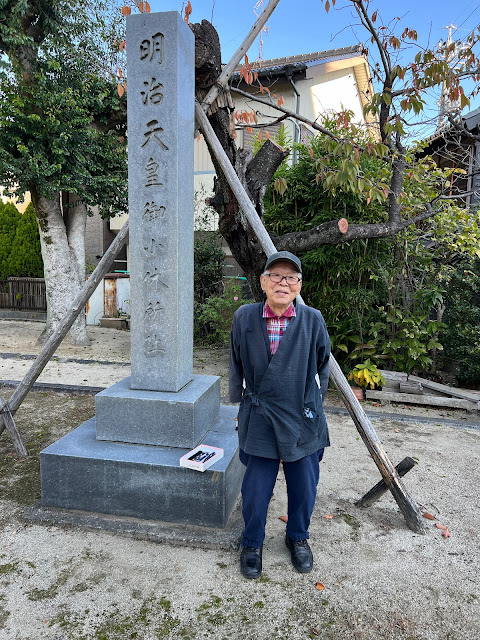I caught a train back to Shin-Anjo, where arriving passengers transferred into lines for buses bearing names like Mitsubishi and Denlo. Toyota City (named after the car maker, not the other way around) is not far from here, and I guess this area is one of the major centres of Japan’s auto industry.
I, of course, was relying on a much slower form of transport, and soon came across a nice little shrine half-hidden in a grove of trees, where I paid my respects.
Approaching the Tokaido post town of Chiryu, a pine stood atop an ichirizuka.
A nearby sign explained that an avenue of pines used to stretch for nearly a kilometre, but that housing development has halved the length. A typhoon wrought further destruction in 1952, but in 1971 about 150 new pines were planted and the local authorities work hard to protect the remaining trees.
A pine also features in one of Hiroshige’s prints of the Tokaido stations, which depicts the annual horse fair for which Chiryu was famed for hundreds of years. Of course there’s a roadside reproduction.
The Tokaido makes a left and right turn at the western end of Chiryu, and a park in the angle of the bend offered a spot to have a rest and a couple of mandarins I’d bought from a supermarket yesterday. As I was tidying up and preparing to leave, I noticed an old man who’d appeared on a nearby bench, having a cigarette and smiling in my direction. I bowed and said “konnichiwa”, and he asked me a question. As usual, I apologised for my lack of Japanese and showed him my written introduction. As others have done, he expressed surprise and admiration for the endeavour, and we chatted as best we could.
I asked if he would mind writing his name in my notebook, at which point my pen stopped working and he went into what was obviously his house just behind the park, returning with a box of pens – of which he gave me one as a gift. Functional writing implement secured, he wrote his name in both Hiragana and Romaji, and very kindly agreed to let me take his photograph:
Yoshihiko-san told me he’s 90 years old, but he could easily pass for 10 years younger.
We said our goodbyes, and I turned the corner of the road to find a shop filled with interesting-looking pottery. Peering in the door, who should appear at the back of the shop but Yoshihiko-san. “My home!” he called in English.
I could have bought half a dozen things, but was conscious of the weight and fragility of the items over what would probably be another 20 km of walking today. In the end I settled on just one, for a Christmas present. As I handed over the money, he invited me into the back of the shop, pointed to a cushion and in an instant produced a pot of green tea and a cup. The tea was delicious, and I was enjoying it while Yoshihiko-san pottered about in the shop when Yoshiko-san, his wife, appeared (I obviously looked confused at the similarity of the names, as they laughed and assured me I’d understood them properly). Yoshihiko-san explained who I was, where I was from and what I was doing, and his wife produced a bag of mandarins to help me on my way. Pen, tea, mandarins … these little moments of spontaneous generosity are so touching.
There were many smiles and much laughter as we did our best to communicate in Japanese, English, sign language and (when all else failed) Google Translate. But eventually I had to be on my way, and I am delighted to say that I was able to photograph them both in the doorway of their shop.
But the ramen was delicious, and I felt fully re-energised as I set off again.
Things got more interesting when I reached the district of Arimatsu, which is famous for having preserved its Edo-era streetscape and for traditional tie-dying techniques, of which I think it’s the leading centre in Japan. Most of the businesses on the Tokaido street frontage feature the town’s name in Hiragana on tie-dyed noren curtains.
I stopped in at a shop and bought a traveller’s hand cloth (essential in Japan, as many public bathrooms don’t have hand drying facilities), but I can’t help thinking someone with a better appreciation of textiles and related matters would have got more out of the town than I did. The street was lovely, though.
(That’s a freeway overpass in the background, by the way.)
Update: You can learn more about shibori, the traditional tie-dyeing techniques of Arimatsu, here.
This is the hand cloth I bought:
Across the Tenpakugawa (Tenpaku River River, according to the sign)…
… to find an ichirizuka with the biggest tree on top yet.
At first I thought it was a type of fig, but Apple’s plant ID tells me it’s a Chinese hackberry. That fits, as several signs along the Tokaido have mentioned hackberries as being a common choice for ichirizuka. Now I know what one looks like.
At Kasadera, a large and particularly beautiful temple was entered via a stone bridge and the traditional gate house …
… and then up a modern ramp to the main temple building itself.



















Comments
Post a Comment